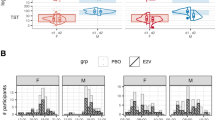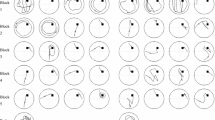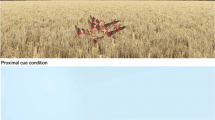Abstract
Studies in human and non-human animals have found that early life exposure to androgens may affect later spatial performance. Recent studies have suggested that the ratio of the second to fourth digit (2D:4D) may serve as an index of prenatal androgen exposure. Some studies have found that the 2D:4D ratio predicts adult spatial performance, although the nature of the relationship is equivocal. This study was designed to quantify the relationships between 2D:4D ratio, spatial cognition, and spatial navigation using a virtual Morris water task (vMWT) in a sample of young adult men and women (N = 140). The results replicated findings from the literature regarding sex differences in 2D:4D ratio, vMWT performance, and spatial cognition. However, 2D:4D ratio was not consistently related to spatial cognition or spatial navigation in men or women. Results were discussed within the framework of androgen influences on spatial cognition and the degree to which 2D:4D ratio serves as a marker for early life androgen exposure.


Similar content being viewed by others
References
Astur, R. S., Ortiz, M. L., & Sutherland, R. J. (1998). A characterization of performance by men and women in a virtual Morris Water task: A large and reliable sex difference. Behavioural Brain Research, 93, 185–190.
Astur, R. S., Tropp, J., Sava, S., Constable, R. T., & Markus, E. (2004). Sex differences and correlations in a virtual Morris water task, a virtual radial arm maze, and mental rotation. Behavioural Brain Research, 151, 103–115.
Benton, A. L., & Hamsher, K. (1976). Multilingual aphasia examination. Iowa City, IA: AJA.
Berenbaum, S. A., Bryk, K. K., Nowak, N., Quigley, C. A., & Moffat, S. (2009). Fingers as a marker of prenatal androgen exposure. Endocrinology, 150, 5119–5124.
Brown, W. M., Hines, M., Fane, B. A., & Breedlove, S. M. (2002). Masculinized finger length patterns in human males and females with congenital adrenal hyperplasia. Hormones and Behavior, 42, 380–386.
Buck, J. J., Williams, R. M., Hughes, I. A., & Acerini, C. L. (2003). In utero exposure and 2nd to 4th digit length ratio—Comparisons between healthy controls and females with classical congenital adrenal hyperplasia. Human Reproduction, 18, 976–979.
Burkitt, J., Widman, D., & Saucier, D. M. (2007). Evidence for the influence of testosterone in the performance of spatial navigation in a virtual water maze in women but not in men. Hormones and Behavior, 51, 649–654.
Burton, L. A., Henninger, D., & Hafetz, J. (2005). Gender differences in relations of mental rotation, verbal fluency, and SAT scores to finger length ratios as hormonal indexes. Developmental Neuropsychology, 28, 493–505.
Clemens, L., Gladue, B., & Coniglio, L. (1978). Prenatal endogenous androgenic influences on masculine sexual behavior and genital morphology in male and female rats. Hormones and Behavior, 10, 40–53.
Cole-Harding, S., Morstad, A., & Wilson, J. (1988). Spatial abilities in members of opposite sex twin pairs [Abstract]. Behavior Genetics, 18, 710.
Collaer, M. L., & Hines, M. (1995). Human behavioral sex differences: A role for gonadal hormones during early development. Psychological Bulletin, 118, 55–107.
Coluccia, E., & Louse, G. (2004). Gender differences in spatial orientation: A review. Journal of Environmental Psychology, 24, 329–340.
Coolican, J., & Peters, M. (2003). Sexual dimorphism in the 2D/4D ratio and its relation to mental rotation performance. Evolution and Human Behavior, 24, 179–183.
Dawson, J. L., Cheung, Y. M., & Lau, R. T. (1975). Developmental effects of neonatal sex hormones on spatial and activity skills in the white rat. Biological Psychology, 3, 213–229.
Driscoll, I., Hamilton, D. A., Yeo, R. A., Brooks, W. M., & Sutherland, R. J. (2005). Virtual navigation in humans: The impact of age, sex, and hormones on place learning. Hormones and Behavior, 47, 326–335.
Ekstrom, R. B., French, J. W., & Harman, H. (1976). Manual for kit of factor-referenced cognitive tests. Princeton, NJ: Educational Testing Service.
Epic Games. (2003). Unreal tournament 2003. Raleigh, NC: Epic Games Inc.
Falter, C. M., Arroyo, M., & Davis, G. J. (2006). Testosterone: Activation or organization of spatial cognition? Biological Psychology, 73, 132–140.
Galis, F., Ten Broek, C. M. A., Van Dongen, S., & Wijnaendts, L. C. D. (2009). Sexual dimorphism in the prenatal digit ratio (2D:4D). Archives of Sexual Behavior, 39, 57–62.
Gladue, B. A., Beatty, W. W., Larson, J., & Staton, R. D. (1990). Sexual orientation and spatial ability in men and women. Psychobiology, 18, 101–108.
Grimbos, T., Dawood, K., Burris, R., Zucker, K. J., & Puts, D. A. (2010). Sexual orientation and the second to fourth finger length ratio: A meta-analysis in men and women. Behavioral Neuroscience, 124, 278–287.
Hines, M., Fane, B. A., Pasterski, V. L., Mathews, G. A., Conway, G. S., & Brook, C. (2003). Spatial abilities following prenatal androgen abnormality: Targeting and mental rotations performance in individuals with congenital adrenal hyperplasia. Psychoneuroendocrinology, 28, 1010–1026.
Hyde, J. S. (1981). How large are cognitive gender differences? American Psychologist, 36, 892–901.
Isgor, C., & Sengelaub, D. R. (2003). Effects of neonatal gonadal steroids on adult CA3 pyramidal neuron dendritic morphology and spatial memory in rats. Journal of Neurobiology, 55, 179–190.
Jonasson, Z. (2005). Meta-analysis of sex differences in rodent models of learning and memory: A review of behavioral and biological data. Neuroscience and Biobehavioral Reviews, 28, 811–825.
Joseph, R., Hess, S., & Birecree, E. (1978). Effects of hormone manipulations and exploration on sex differences in maze learning. Behavioral Biology, 24, 364–377.
Kaufman, A. S. (1990). Assessing adolescent and adult intelligence. Boston: Allyn and Bacon.
Koscik, T., O’Leary, D., Moser, D. J., Andreasen, N. C., & Nopoulos, P. (2009). Sex differences in parietal lobe morphology: Relationship to mental rotation performance. Brain and Cognition, 69, 451–459.
Linn, M. C., & Petersen, A. C. (1985). Emergence and characterization of gender differences in spatial abilities: A meta-analysis. Child Development, 56, 1479–1498.
Lutchmaya, S., Baron-Cohen, S., Raggatt, P., Knickmeyer, R., & Manning, J. T. (2004). 2nd to 4th digit ratios, fetal testosterone and estradiol. Early Human Development, 77, 23–28.
Maccoby, E. E., & Jacklin, C. N. (1974). Psychology of sex differences. Stanford, CA: Stanford University Press.
Malas, M. A., Dogan, S., Evcil, E. H., & Desdicioglu, K. (2006). Fetal development of hand, digits and digit ratio (2D:4D). Early Human Development, 82, 469–475.
Malinowski, J. C., & Gillespie, W. T. (2001). Individual differences in performance on a large-scale, real-world wayfinding task. Journal of Environmental Psychology, 21, 73–82.
Manning, J. T. (2002). Digit ratio: A pointer to fertility, behavior, and health. Piscataway, NJ: Rutgers University Press.
Manning, J. T., Callow, M., & Bundred, P. E. (2003). Finger and toe ratios in humans and mice: Implications for the etiology of diseases influenced by HOX genes. Medical Hypotheses, 60, 340–343.
Manning, J. T., Scutt, D., Wilson, J., & Lewis-Jones, D. I. (1998). The ratio of 2nd to 4th digit length: A predictor of sperm numbers and levels of testosterone, LH and oestrogen. Human Reproduction, 13, 3000–3004.
Manning, J. T., Stewart, A., Bundred, P. E., & Trivers, R. L. (2004). Sex and ethnic differences in 2nd and 4th digit ratio of children. Early Human Development, 80, 161–168.
Manning, J. T., & Taylor, R. P. (2001). 2nd to 4th digit ratio and male ability in sport: Implication for sexual selection in humans. Evolution and Human Behavior, 22, 61–69.
Matarazzo, J. D. (1972). Wechsler’s measurement and appraisal of adult intelligence. Baltimore: Williams and Wilkins.
McCormick, C. M., & Witelson, S. F. (1991). A cognitive profile of homosexual men compared to heterosexual men and women. Psychoneuroendocrinology, 15, 459–473.
McFadden, D., & Bracht, M. S. (2009). Sex and race differences in the relative lengths of metacarpals and metatarsals in human skeletons. Early Human Development, 85, 117–124.
McFadden, D., & Shubel, E. (2002). Relative lengths of fingers and toes in human males and females. Hormones and Behavior, 42, 492–500.
Microsoft Corporation. (2002). Sidewinder joystick. Redmond, WA: Microsoft Corporation.
Moffat, S. D., Hampson, E., & Hatzipantelis, M. (1998). Navigation in a “virtual” maze: Sex differences and correlation with psychometric measures of spatial ability in humans. Evolution and Human Behavior, 19, 73–87.
Money, J., Alexander, D., & Walker, H. T. (1965). A standardized road-map test of direction sense. Baltimore: Johns Hopkins Press.
Morris, R. G. M. (1984). Developments of a water-maze procedure for studying spatial learning in the rat. Journal of Neuroscience Methods, 11, 47–60.
Mueller, S. C., Jackson, C. P. T., & Skelton, R. W. (2008). Sex differences in a virtual water maze: An eye tracking and pupillometry study. Behavioural Brain Research, 193, 209–215.
Neave, N., Menaged, M., & Weightman, D. R. (1999). Sex differences in cognition: The role of testosterone and sexual orientation. Brain and Cognition, 41, 245–262.
Okten, A., Kalyoncu, M., & Yaris, N. (2002). The ratio of second and fourth digit lengths and congenital adrenal hyperplasia due to 21-hydroxylase deficiency. Early Human Development, 70, 47–54.
Peters, M., Manning, J. T., & Reimers, S. (2007). The effects of sex, sexual orientation, and digit ratio (2D:4D) on mental rotation performance. Archives of Sexual Behavior, 36, 251–260.
Puts, D. A., Gaulin, S. J., Sporter, R. J., & McBurney, D. H. (2004). Sex hormones and finger length. What does 2D:4D indicate? Evolution and Human Behavior, 25, 182–199.
Puts, D. A., McDaniel, M. A., Jordan, C. L., & Breedlove, S. M. (2008). Spatial ability and prenatal androgens: Meta-analyses of congenital adrenal hyperplasia and digit ratio (2D:4D) studies. Archives of Sexual Behavior, 37, 100–111.
Quigley, C. A., De Bellis, A., Marschke, K. B., El-Awady, M. K., Wilson, E. M., & French, F. S. (1995). AR defects: Historical, clinical, and molecular perspectives. Endocrine Reviews, 16, 271–321.
Rahman, Q., Andersson, D., & Govier, E. (2005). A specific sexual orientation-related difference in navigation strategy. Behavioral Neuroscience, 119, 311–316.
Rahman, Q., & Koerting, J. (2008). Sexual orientation-related differences in allocentric spatial memory tasks. Hippocampus, 18, 55–63.
Rahman, Q., & Wilson, G. D. (2003). Large sexual orientation related differences in performance on mental rotation and judgment of line orientation. Neuropsychology, 17, 25–31.
Rahman, Q., Wilson, G. D., & Abrahams, S. (2003). Sexual orientation related differences in spatial memory. Journal of the International Neuropsychological Society, 9, 376–383.
Resnick, S. M., Berenbaum, S. A., Gottesman, I. I., & Bouchard, T. J. (1986). Early hormonal influences on cognitive functioning in congenital adrenal hyperplasia. Developmental Psychology, 22, 191–198.
Roof, R. L. (1993). Neonatal exogenous testosterone modifies sex differences in radial arm and Morris water maze performance in prepubescent and adult rats. Behavioural Brain Research, 53, 1–10.
Roof, R. L., & Havens, M. D. (1992). Testosterone improves maze performance and induces development of a male hippocampus in females. Brain Research, 572, 310–313.
Sanders, G., Bereczkei, T., Csatho, A., & Manning, J. T. (2005). The ratio of the 2nd to 4th finger length predicts spatial ability in men but not women. Cortex, 41, 789–795.
Sanders, G., & Ross-Field, L. (1986). Sexual orientation and visuo-spatial ability. Brain and Cognition, 5, 280–290.
Sandstrom, N. J., Kaufman, J., & Huettel, S. (1998). Males and females use different distal cues in a virtual environment navigation task. Cognitive Brain Research, 6, 351–360.
Smail, P. J., Reyes, F. I., Winter, J. S. D., & Faiman, C. (1981). The fetal hormone environment and its effect on the morphogenesis of the genital system. In S. J. Kogan & E. S. E. Hafez (Eds.), Pediatric andrology (pp. 9–20). The Hague: Martinus Nijhoff.
Speiser, P. W., & White, P. C. (2003). Congenital adrenal hyperplasia. New England Journal of Medicine, 349, 776–788.
Stewart, J., Skvarenina, A., & Pottier, J. (1975). Effects of neonatal androgens on open-field behavior and maze learning in the prepubescent and adult rat. Physiology & Behavior, 14, 291–295.
Tabachnick, B. G., & Fidell, L. S. (2001). Using multivariate statistics (4th ed.). Boston: Allyn & Bacon.
Ullman, M. T., Miranda, R. A., & Travers, M. L. (2008). Sex differences in the neurocognition of language. In J. B. Becker, K. J. Berkley, N. Geary, E. Hampson, J. P. Herman, & E. A. Young (Eds.), Sex differences in the brain: From genes to behavior (pp. 291–309). New York: Oxford University Press.
van Anders, S. M., & Hampson, E. (2005). Testing the prenatal androgen hypothesis: Measuring digit ratios, sexual orientation, and spatial abilities in adults. Hormones and Behavior, 47, 92–98.
van Anders, S. M., Vernon, P. A., & Wilbur, C. J. (2006). Finger-length rations show evidence of prenatal hormone-transfer between opposite-sex twins. Hormones and Behavior, 49, 315–319.
Vandenberg, S. G., & Kuse, A. R. (1978). Mental rotations, a group test of three-dimensional spatial visualization. Perceptual and Motor Skills, 47, 599–604.
Voyer, D., Voyer, S., & Bryden, M. (1995). Magnitude of sex differences in spatial abilities: A meta-analysis and consideration of critical variables. Psychological Bulletin, 117, 250–270.
Wegesin, D. J. (1998). A neuropsychologic profile of homosexual and heterosexual men and women. Archives of Sexual Behavior, 27, 91–108.
Williams, C. L., Barnett, A. M., & Meck, W. H. (1990). Organizational effects of early gonadal secretions on sexual differentiation in spatial memory. Behavioral Neuroscience, 104, 84–97.
Author information
Authors and Affiliations
Corresponding author
Rights and permissions
About this article
Cite this article
Nowak, N.T., Moffat, S.D. The Relationship Between Second to Fourth Digit Ratio, Spatial Cognition, and Virtual Navigation. Arch Sex Behav 40, 575–585 (2011). https://doi.org/10.1007/s10508-010-9668-2
Received:
Revised:
Accepted:
Published:
Issue Date:
DOI: https://doi.org/10.1007/s10508-010-9668-2




